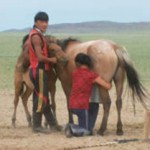by Adrienne Mayor (Wonder & Marvels contributor)
Amazons, those fabled women warriors of the steppes, were working mothers too busy to breastfeed. According to the ancient Greeks, they nourished their infants with mare’s milk. Since Homer, nomadic tribes from the Black Sea to Mongolia were known as “mare-milking Scythians.” That notion was exotic enough, but the Greeks would have been surprised to learn that the babies’ milk contained alcohol.
Milk from horses is nutritious but because of its high lactose content raw mare’s milk is a strong laxative. It requires fermentation to be a viable source of nutrition, even for babies. During fermentation the milk is agitated or churned like butter. The lactobacilli bacteria acidify the milk and yeasts create carbonated ethanol. The result is mildly alcoholic koumiss high in calories and vitamins. (Koumiss is similar to kefir, a fermented, less alcoholic milk drink of the Caucasus.) Scythian men and women preferred a stronger alcoholic punch than the drink given to babies. (One ancient Amazon’s name translates as “Drunkard.”) The nomads discovered how to enrich fermented milk by the process now known as “freeze distillation.” No strangers to snow, the nomads would allow the fermented milk to freeze, thaw it, remove the ice crystals, refreeze, and repeat until the desired alcoholic level was reached.
The Greek historian Herodotus (ca 450 BC) observed mare milk churning on a large scale among the settled Scythians on the Black Sea. They poured the milk into deep wooden casks, then stirred vigorously as it fermented. What rose to the top was drawn off and drunk. The early European traveler William of Rubruck, who trekked across the steppes ca AD 1250, watched the same process: “As the nomads churn the milk it begins to ferment and bubble up like new wine.” He sampled the effervescent beverage and found it pungent and intoxicating. “Koumiss makes the inner man most joyful!” Smaller batches of koumiss were fermented in leather bags by families on the move. In Inner Asia, the custom was to hang the sack where passersby could periodically punch the bag to agitate the koumiss. Koumiss is a favorite drink from the Black Sea to western China.
How ancient is koumiss? Historical linguistics and archaeology provide clues. The three most ancient alcoholic beverages are mead (fermented honey), kvass (beer), and koumiss. Kvass and mead have cognates in Proto-Indo-European languages, while koumiss derives from the ancient Central Asian Turkic language family. So koumiss originated along with the domestication of the horse on the steppes more than 5,000 years ago.
Lipids from horse milk can be identified on artifacts in ancient burials. Bowls containing residue of mare’s milk have been discovered in Botai culture dwellings of about 3500 BC in Kazakhstan. These people were among the first to tame wild horses. Evidence for fermented mare’s milk is also found in the graves of Scythian men and women. Special utensils for beating koumiss and drinking vessels with traces of horse milk are common grave goods. The famous Golden Warrior of Issyk (Kazakhstan) was accompanied by koumiss beaters and bowls that held traces of mare’s milk. In the grave of the tattooed “Ice Princess” (Ukok, Russia) archaeologists discovered a wooden stirring stick in a cup decorated with snow leopards. Inside the cup was the residue of koumiss that would sustain her in the Afterlife.
About the author: Adrienne Mayor is a Research Scholar in Classics and History of Science, Stanford University. She is the author of “The Amazons: Lives and Legends of Warrior Women across the Ancient World” (2104), and “The Poison King: The Life and Legend of Mithradates, Rome’s Deadliest Enemy,” nonfiction finalist for the 2009 National Book Award.
